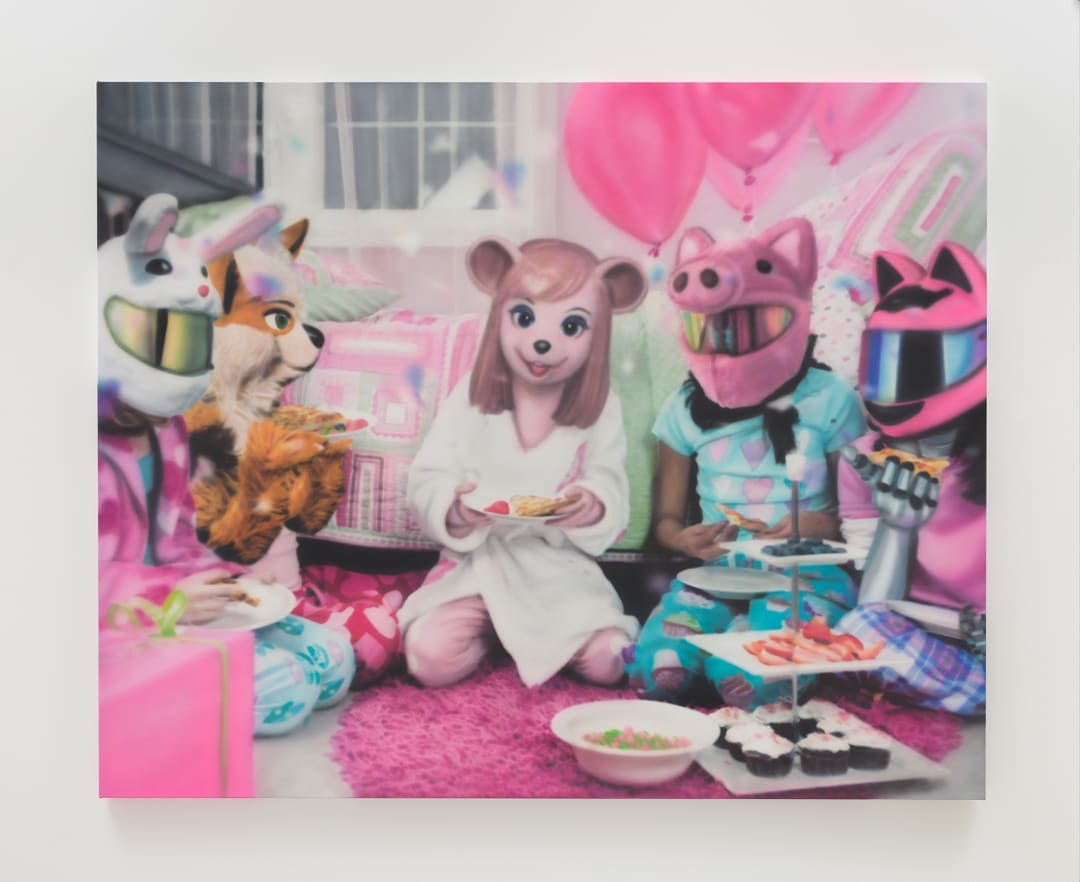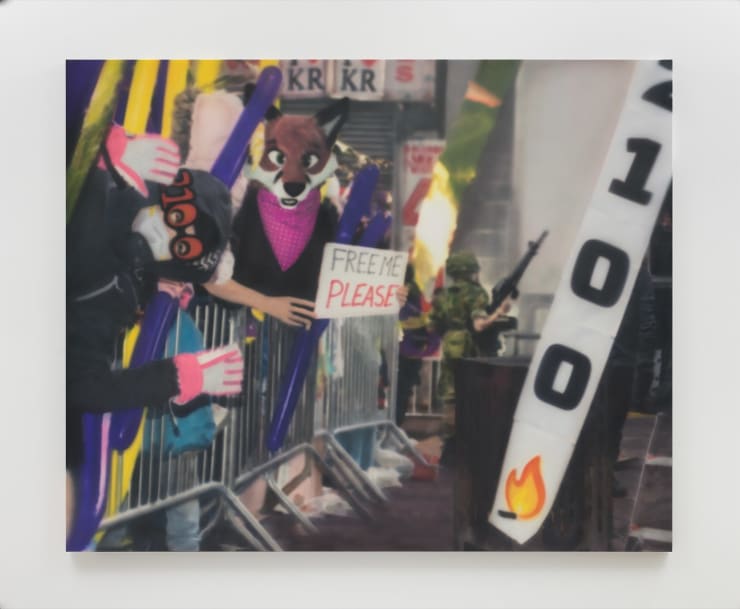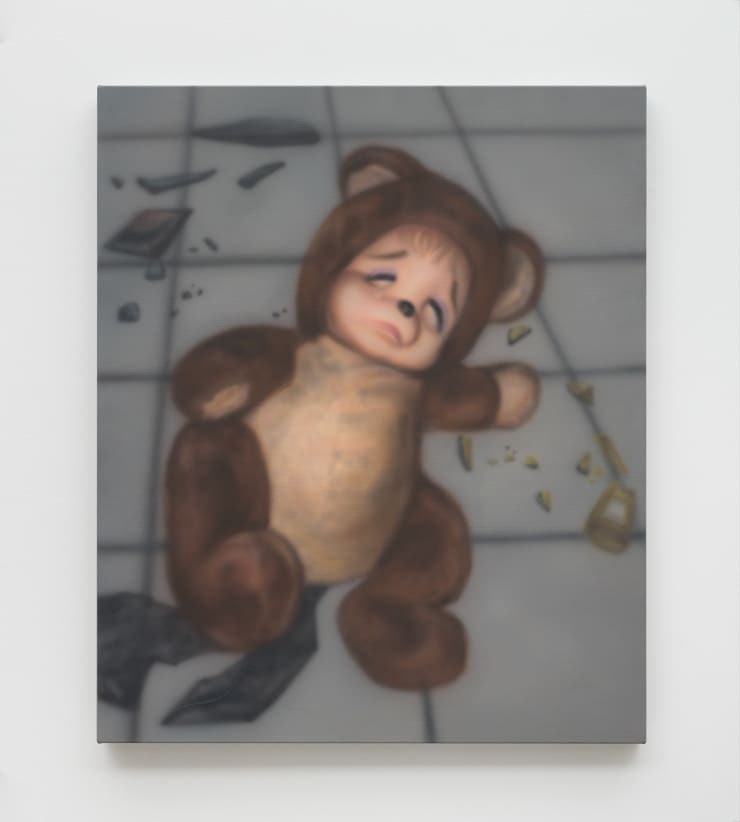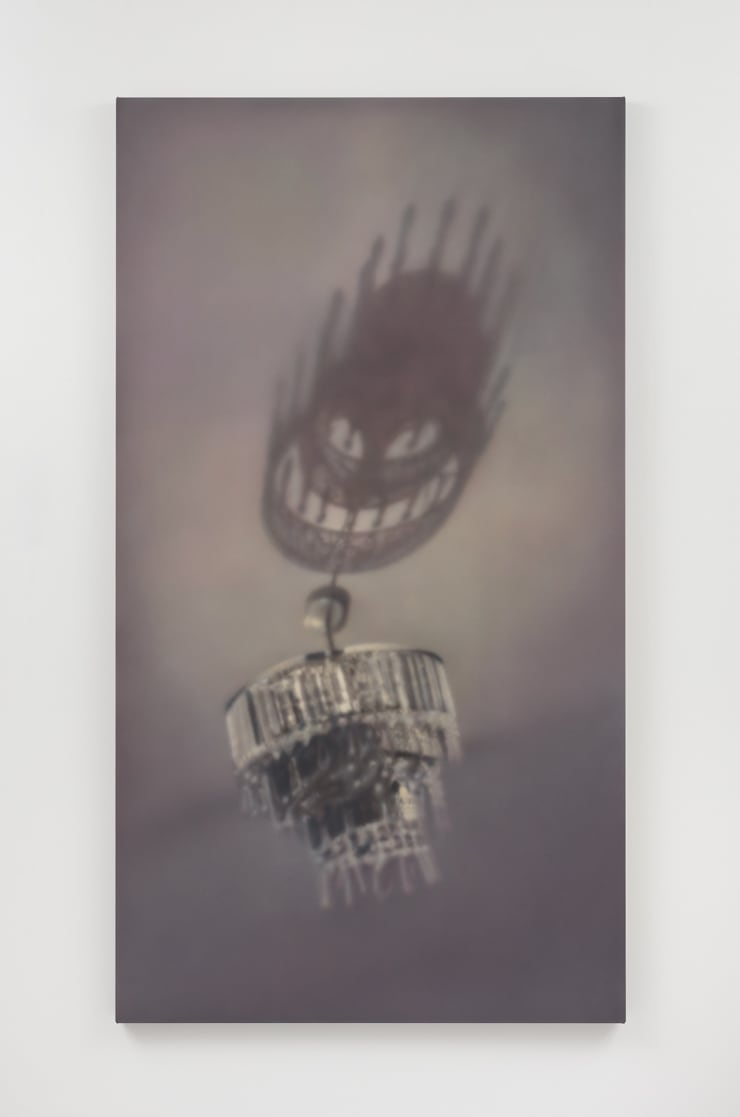Jihyoung Han: Lavish Bone
Jihyoung Han: Lavish Bone
November 9 – December 21, 2024 (Tue-Sat 10:00-18:00)
Jason Haam Gallery is pleased to present Lavish Bone, the first solo exhibition by Jihyoung Han with the gallery. The exhibition runs from November 9 to December 21, with an opening reception on November 9 at 4 PM.
The Body’s Struggle for Its Own Existence
By Wonseok Koh, Director, Line Cultural Foundation
Jihyoung Han has quickly gained recognition for her distinctive paintings that incorporate futuristic imagery. Her works, distinguished by their bold visuals and distinct atmosphere, have featured in several exhibitions and has established a strong presence in Seoul and beyond.
Her solo exhibition Lavish Bone marks a shift from previous shows, offering a deeper dive into recurring themes she has been engaging with. This exhibition offers a close look at the artist’s vision of the “future” and the “body,” examining the underlying concepts that drive her work and invites reflection on the structural characteristics that are likely to shape Han’s ongoing practice.
In the exhibition statement, Han describes her work as an exploration of imagined landscapes from the year 2100, invoking terms like “the end of the world” and “ruined landscapes.” These dystopian landscapes are common in her paintings, reflecting the apocalyptic imagery that dominates much of today’s media, including films and video games. In truth, visions of the future are often shaped by the concerns and imaginations of the present, making them highly reflective of contemporary anxieties. Han’s dystopian landscapes take on added meaning as they reflect not just her personal imagination but also the collective unease of her generation. Her works critique the modern coexistence of war and entertainment, imagining a future where humanity’s violent instincts and societal tensions are amplified. Distorted figures, contorted bodies, unsettling backdrops, and heavy, surreal color palettes evoke a brooding, oppressive atmosphere.
However, there is an ambivalence in the future Han portrays. Her dystopian landscapes carry not just a critique of contemporary absurdities but also a sense of attachment and anxiety over its potential loss. This duality—both a critique and a nostalgia for the present—seems to lie at the heart of what gives Han’s paintings their unique tension. The bleak scenes of fractured social bonds, depersonalized relationships, and affection devoid of emotion may, in fact, represent a reverse longing for what is feared to be lost.
The body plays a central role in Han’s work and is frequently shown in states of transformation. These transformations go beyond mere aesthetic choices, suggesting fundamental shifts in identity. In her figure-centric compositions, the transformed body serves as a key indicator of the future.
Yet, the body transformations in Han’s work stand apart from the optimistic ideals of transhumanism, which assumes the ultimate upgrade of the body in an Extropian perspective. The title Lavish Bone hints at a future where maintaining the natural body is considered a luxury. Han suggests that in the future, frequent bodily modifications will become a means of expressing vested interests or power dynamics. In this future society, bodily modification becomes a standard means of expressing status, with extreme physical alterations becoming the norm. The body is no longer merely a personal asset but something completely subsumed into collective hierarchies. The familiar feeling that some of Han’s transformed bodies evoke might come from today’s idealized, curated images on social media—bodies reshaped by capital and technology. These transformations may, in turn, reflect the shadow of contemporary power dynamics.
The transformed bodies in Han’s paintings often adopt animal-like traits, not as a literal representation of animals but as avatars or commercialized characters imposed upon the human form. These figures may be avatars or memes, constantly adapting to societal norms in a future where direct self-expression feels increasingly alien.
Han’s vision of the future extends directly from today’s reality. The dystopian signs she portrays can already be seen in contemporary aesthetics, distorted by global platforms driven by commercial interests.
Her paintings capture these fragmented, momentary glimpses in a glitch-like state, resisting clear narrative structures. The disjointed, time-fractured moments she presents feel less like visions of the future and more like reflections of the present.
한지형: 사치스런 뼈
2024년 11월 9일 – 12월 21일 (화-토 10:00-18:00)
제이슨함 갤러리는 한지형 작가의 개인전 Lavish Bone (사치스런 뼈)을 선보입니다. 이번 전시는 제이슨함과 한지형 작가가 함께하는 첫 개인전으로, 11월 9일부터 12월 21일까지 진행되며, 오프닝 리셉션은 11월 9일 토요일 오후 4시부터 시작됩니다.
소멸이 두려운 신체의 존립투쟁
-고원석, 라인문화재단 디렉터
한지형은 미래적 이미지를 담은 독특한 회화작업들로 짧은 시간에도 불구하고 많은 주목을 받았다. 시선을 잡아채는 강렬한 이미지나 특별한 분위기를 풍기는 그의 작업은 최근 여러 전시를 통해 많은 사람들의 관심의 대상이 되어왔다. 때문에 신진 작가라는 수식어가 어색할 만큼 탄탄한 이력을 쌓아오며 서울을 비롯해 해외의 여러 도시에서 열린 전시에 참여해왔다.
≪사치스런 뼈(Lavish Bone)≫라는 제목이 붙은 이번 개인전은 이전의 개인전이 일종의 프로젝트 성격으로 구성되었던 것에 비해 그간 작가가 다뤘던 몇 가지 요소들이 면면히 드러난 작품들로 구성된다. 이 글은 미래와 신체라는 키워드를 통해 그의 작품들이 짚고 있는 내용적 측면을 살펴보게 될 것이다. 형식적인 특징이나 이미지의 본질에 대한 언급들은 이미 다른 글에서 몇 차례 다뤄지기도 했거니와, 이후로 펼쳐질 긴 작업활동의 초기 단계에 와있는 작가가 견지할 가능성이 높은 작업세계의 구조적 특징을 가늠해보는 데 더 큰 흥미를 느끼기 때문이다.
전시를 위한 작가노트에서 한지형은 이번 개인전을 다가올 2100년을 상상하며 그려낸 미래의 풍경들을 보여주는 전시라고 소개한다. 거기엔 ‘세계의 끝’, ‘폐허적 풍경’ 등의 단어가 등장하는데, 마찬가지로 그의 회화에도 다분히 디스토피아적인 미래 풍경이 묘사되어 있다. 물론 오늘날 미래를 예상하는 영화나 게임도 대부분 재난과 폐허의 이미지로 점철되어 있다. 사실 미래의 이미지는 현재의 시선과 상상력이 지배하는 지극히 타협적이고 현실적인 집단적 사고의 결과들이다. 한지형의 미래적 풍경은 작가가 속한 세대 혹은 사회의 분위기가 작가 고유의 상상력과 조형감각을 만나서 구축된 이미지라는 점에서 의미를 갖는다. 한지형은 디스토피아적 미래 풍경의 이미지들이 상상력을 자극하는 대중문화의 환경에서 자신의 취향을 배양해온 세대이기도 하지만, 동시에 전쟁과 오락이 병존하는 동시대를 비판적으로 바라보고, 미래를 비관적인 것으로 상상하는 작가이기도 하다. 그의 작품에는 인간 존재의 폭력적 본질과 그에 대한 사회적 저항 등이 심화되고 확장된 미래의 음울한 전조들이 담겨있다. 뒤틀리거나 변형된 신체의 빈번한 등장이나 좀처럼 파악하기 어려운 배경, 무겁고 비현실적인 색감 등이 그러한 분위기를 잘 표현하고 있다.
그런데 한지형이 표현하는 미래의 풍경에는 일종의 양가성이 엿보이기도 한다. 즉 그의 작품 속의 디스토피아적 풍경에는 동시대의 부조리에 대한 비판과 함께 동시대에 대한 애착과 상실의 불안감이 공존하는 것 같다. 일종의 이중적 현실인식 이라고 볼 수 있는 이러한 양가성이야말로 그의 회화가 발산하는 독특함의 원인으로 보인다. 분화되어 힘을 잃은 사회적 연대, 인간적 친밀감이 제거된 친교, 정동이 전혀 느껴지지 않는 애정행위 등 그의 작품이 묘사하는 미래의 비관적 장면들은 어쩌면 소멸되지 않기를 바라는 것들에 대한 반어적 표현이 아닐까?
한편 한지형의 작품에서 대부분의 신체는 변형되어 있다. 변형의 스케일은 단순히 외피를 취향적으로 장식하는 수준이 아니라, 본질적인 정체성을 변화시키는 정도로 이루어진다. 배경이 제한되어 있고 인물이 주를 이루는 그의 회화에서 변형된 신체는 미래를 암시하는 주된 단서로 기능한다.
물론 그가 말하는 신체 변형은 트랜스휴머니즘(Transhumanism)이 전제하는 낙관주의, 즉 신체의 궁극적 업그레이드를 가정하는 엑스트로피안(Extropian)적 관점과는 거리가 멀다. 이번 전시의 제목인 ‘사치스런 뼈’에는 신체의 원형을 유지하는 것이 일종의 사치로 여겨지는 미래사회적 분위기가 암시되어 있다. 작가는 이해나 권력관계를 드러내는 수단으로 빈번한 신체의 변형이 일어나는 것이 미래의 풍경일 것이라고 말한다. 다른 사람들과 차별화된 신체야말로 사치의 수단이며, 남들과 최대한 다르게 신체를 변형 혹은 개조시키는 것이 보편적인 일상이 될 것이라는 말이다. 그러한 사회에서의 신체는 지극히 권력적이고 집단적인 위계와 질서에 자발적으로, 그리고 완벽하게 종속된 대상이다. 그런데 그렇게 변형된 미래의 신체 이미지에서 기시감이 든다면, 그것은 오늘날 소셜미디어에 수시로 등장하는 매력적인 신체의 이미지, 즉 자본과 기술이 개조시킨 완성형(이라고 믿어지는) 신체에서 확장된 것이기 때문은 아닐까? 그렇다면 결국 변형의 (비)자발적 동기는 당대에 작동하는 현실권력의 그림자일수도 있을 것이다. 언뜻 한지형의 회화에서 변형된 신체의 디테일은 대부분 인간의 신체에 동물의 요소들이 가미된 것들로 보이는데, 이는 동물 그 자체가 아니라 동시대 상업자본을 배경으로 하는 캐릭터들을 신체에 적용시킨 것으로 볼 수 있겠다. 그러한 캐릭터들이 얼굴을 대체하고 있는 건 어쩌면 스스로의 정체성을 직설적으로 드러내는 것이 어색한 미래사회의 분위기에서 상시적으로 등장시키는 아바타나 밈 같은 것은 아닐까? 2100년의 신체에 적용된 캐릭터가 지금도 유행하는 레트로피아(Retropia)적 취향의 반복된 유행 때문일지는 모르지만 말이다.
한지형이 상상하는 미래는 사실 현재의 경험적 환경의 틀에서 연장된 것에 가깝다. 그가 파악하는 디스토피아적 미래의 징후는 오늘날 대다수의 일상을 점유하는 거대 자본의 글로벌한 플랫폼이 주도하는 왜곡된 미의식에서 찾아볼 수 있다.
그의 회화는 그러한 풍경들을 포착하여 보여주고 있지만, 지극히 순간적이다. 그가 드러내는 이미지는 분명한 대상으로 구현되지 않은, 일종의 글리치 상태에 가깝다. 엉켜 있는 듯한 형상과 불분명한 윤곽은 재현성과 서사구조를 회피한다. 분절되고 파편화되어 전후 시간성을 상실한 분열적 순간들은 미래의 현현이 아니라 현재의 모습들이다.
-
 HAN Jihyoung, When the Day Dawns We'll Leave 날이 밝으면 우리는 떠날거야, 2024
HAN Jihyoung, When the Day Dawns We'll Leave 날이 밝으면 우리는 떠날거야, 2024 -
 HAN Jihyoung, Stand Amazed 경외하며 일어서다, 2024
HAN Jihyoung, Stand Amazed 경외하며 일어서다, 2024 -
 HAN Jihyoung, For those of you who were born too late 너무 늦게 태어난 사람들을 위해, 2024
HAN Jihyoung, For those of you who were born too late 너무 늦게 태어난 사람들을 위해, 2024 -
 HAN Jihyoung, The sheer ambition 희미한 포부 , 2024
HAN Jihyoung, The sheer ambition 희미한 포부 , 2024 -
 HAN Jihyoung, The Luncheon on the bed 침대 위의 점심식사, 2024
HAN Jihyoung, The Luncheon on the bed 침대 위의 점심식사, 2024 -
 HAN Jihyoung, No one knows each other 아무도 서로를 모른다, 2024
HAN Jihyoung, No one knows each other 아무도 서로를 모른다, 2024 -
 HAN Jihyoung, You should live twice 두번째 삶, 2024
HAN Jihyoung, You should live twice 두번째 삶, 2024 -
 HAN Jihyoung, What always happens 항상 일어나는 일, 2024
HAN Jihyoung, What always happens 항상 일어나는 일, 2024 -
 HAN Jihyoung, A sad foreshadowing of things to come 이제 곧 닥쳐올 사태에 대한 슬픈 예감, 2024
HAN Jihyoung, A sad foreshadowing of things to come 이제 곧 닥쳐올 사태에 대한 슬픈 예감, 2024 -
 HAN Jihyoung, You look like a memory 당신은 기억을 닮았어, 2024
HAN Jihyoung, You look like a memory 당신은 기억을 닮았어, 2024 -
 HAN Jihyoung, There is no one to help them 그들을 돕는 이가 하나도 없네, 2024
HAN Jihyoung, There is no one to help them 그들을 돕는 이가 하나도 없네, 2024 -
 HAN Jihyoung, We’re from nowhere-i 어디에서도 오지 않은 이들 -i, 2024
HAN Jihyoung, We’re from nowhere-i 어디에서도 오지 않은 이들 -i, 2024 -
 HAN Jihyoung, We’re from nowhere-ii 어디에서도 오지 않은 이들 -ii, 2024
HAN Jihyoung, We’re from nowhere-ii 어디에서도 오지 않은 이들 -ii, 2024 -
 HAN Jihyoung, Don't bully me because I'm different 다르다고 괴롭히지 마, 2024
HAN Jihyoung, Don't bully me because I'm different 다르다고 괴롭히지 마, 2024
















